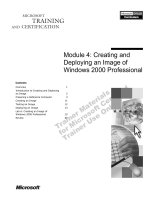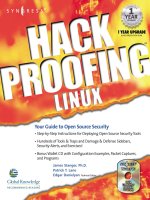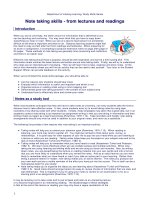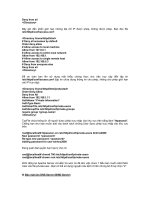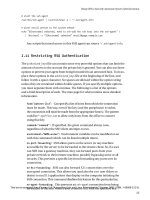Module Linux essentials - Module 2: Open source applications and licenses
Bạn đang xem bản rút gọn của tài liệu. Xem và tải ngay bản đầy đủ của tài liệu tại đây (95.9 KB, 27 trang )
Module 2
Open Source Applications and
Licenses
This slide deck is for LPI Academy instructors to use for lectures for LPI Academy courses.
©Copyright Network Development Group 2013.
Exam Objective
1.2 Major Open Source
Objective Summary
Applications
–
Understanding Desktop, Server, and Mobile
Applications
–
Introducing Development Languages and
Package Management
This slide deck is for LPI Academy instructors to use for lectures for LPI Academy courses.
©Copyright Network Development Group 2013.
The Many Faces of Linux
This slide deck is for LPI Academy instructors to use for lectures for LPI Academy courses.
©Copyright Network Development Group 2013.
Linux plays many roles
•
Servers are usually unattended and
handle data on behalf of other machines
–
•
•
•
file servers, web servers, mail servers
Desktops a.k.a. clients are more
interactive, often graphical
Mobile is a tablet or phone
Development is much like a desktop but
with more capacity for development
This slide deck is for LPI Academy instructors to use for lectures for LPI Academy courses.
©Copyright Network Development Group 2013.
Web Servers
•
•
•
Serve static web pages to clients via
HTTP
Can also serve dynamic content by adding
PHP, Java, Ruby, Python, etc
Apache and Nginx are the most popular
web servers
–
65% of websites use Apache or Nginx
This slide deck is for LPI Academy instructors to use for lectures for LPI Academy courses.
©Copyright Network Development Group 2013.
Mail Servers
•
Mail Transfer Agents move email
between sites
–
•
Mail Delivery Agents deliver email to a
user’s mailbox
–
•
sendmail, postfix
Procmail or custom software
POP/IMAP servers let clients download
–
Dovecot, Cyrus
This slide deck is for LPI Academy instructors to use for lectures for LPI Academy courses.
©Copyright Network Development Group 2013.
File Servers
•
•
•
Network File System is the native UNIX
file sharing protocol
Samba allows a Unix machine to emulate
a Windows client and server
Netatalk allows a Unix machine to
emulate an Apple file server
This slide deck is for LPI Academy instructors to use for lectures for LPI Academy courses.
©Copyright Network Development Group 2013.
Infrastructure
•
ISC bind is a Domain Name System
server
–
•
•
resolves names to addresses and more
OpenLDAP is a LDAP server for directory
information
ISC DHCP configures dynamic clients
through the Dynamic Host Configuration
Protocol
This slide deck is for LPI Academy instructors to use for lectures for LPI Academy courses.
©Copyright Network Development Group 2013.
Databases
•
•
•
MySQL and PostgreSQL are relational
database servers
Database servers store and report on
structured data
SQL is a language used to query a
relational database:
–
SELECT * FROM users;
This slide deck is for LPI Academy instructors to use for lectures for LPI Academy courses.
©Copyright Network Development Group 2013.
Graphical Desktop
•
•
•
X-Windows is the base graphical system
–
Provides windows and basic primitives
–
A.k.a. X11 or X.org
Window managers add menus and
window management (open, close, hide,
etc)
Desktop environments provide window
managers and tools
This slide deck is for LPI Academy instructors to use for lectures for LPI Academy courses.
©Copyright Network Development Group 2013.
Window Managers
•
•
•
•
Compiz, FVWM, Enlightenment, Metacity
Takes the basic windows and provides the
chrome to move, close, open, etc
Switches focus between running
applications
Adds menus and application launchers
This slide deck is for LPI Academy instructors to use for lectures for LPI Academy courses.
©Copyright Network Development Group 2013.
Desktop Environment
•
KDE, GNOME, Unity
•
Window manager + tools
–
Basic tools like calculator, games, notepad
–
File manager
–
Workflow tools, such as shortcuts to launch
applications or search the computer
This slide deck is for LPI Academy instructors to use for lectures for LPI Academy courses.
©Copyright Network Development Group 2013.
Office/Productivity
•
•
•
LibreOffice is a fork of OpenOffice
Includes word processor, spreadsheet,
presentation package, drawing tool
Good compatibility with Microsoft Office
file formats
This slide deck is for LPI Academy instructors to use for lectures for LPI Academy courses.
©Copyright Network Development Group 2013.
Web and Email
•
Chromium and FireFox are popular open
source browsers
–
•
These browsers are also cross platform and
popular, ensuring excellent support
Thunderbird, Evolution, and KMail are
popular email clients
–
Use POP/IMAP to retrieve email
This slide deck is for LPI Academy instructors to use for lectures for LPI Academy courses.
©Copyright Network Development Group 2013.
Console tools
•
•
The Shell is the primary way of interacting
with the system
–
Bourne shell family
–
C shell family
–
Other hybrid shells such as ksh and zsh
Text editors
–
Vi/vim
–
Emacs
This slide deck is for LPI Academy instructors to use for lectures for LPI Academy courses.
–
Pico/nano
©Copyright Network Development Group 2013.
Development
•
•
•
Languages are either Compiled or
Interpreted
–
C, C++, Java are compiled
–
PHP, Perl, Ruby, Python are interpreted
Tradeoff of programmer productivity vs
computing resources
Libraries bundle common behavior to
reduce the amount of code needed
This slide deck is for LPI Academy instructors to use for lectures for LPI Academy courses.
©Copyright Network Development Group 2013.
Open Source Licensing
This slide deck is for LPI Academy instructors to use for lectures for LPI Academy courses.
©Copyright Network Development Group 2013.
Exam Objective
1.3 Understanding Open Source
Software
Objective
Summaryand Licensing
–
Describe the various software licenses and
their differences
–
Know the organizations involved in open
source
This slide deck is for LPI Academy instructors to use for lectures for LPI Academy courses.
©Copyright Network Development Group 2013.
Software Licenses
•
•
•
The creator of the software owns the
copyright to the software
The creator grants a software license for
people to use the software
Some licenses take away rights, others
give rights
This slide deck is for LPI Academy instructors to use for lectures for LPI Academy courses.
©Copyright Network Development Group 2013.
Free Software Foundation
•
•
•
•
Started by Richard Stallman in 1985
Also run the GNU project that provides
tools to Linux and other Unix Oses
GPLv2 and GPLv3 licenses allow you to
modify and redistribute the software
Copyleft provision dictates that you must
share source code to your changes
This slide deck is for LPI Academy instructors to use for lectures for LPI Academy courses.
©Copyright Network Development Group 2013.
GPL
•
•
GPL is a popular Free Software license
GPL is “viral” as changes must also use
GPL
•
LGPL lets you link non GPL libraries
•
GPL3 prevents “Tivoization”
–
•
Using proprietary hardware to circumvent GPL
provisions
You may charge a nominal fee to cover
your costs of distribution
This slide deck is for LPI Academy instructors to use for lectures for LPI Academy courses.
©Copyright Network Development Group 2013.
Open Source Initiative
•
•
•
•
Bruce Perens and Eric Raymond started
the OSI in 1998
Copyleft clauses are too extreme, FSF
was too political
OSI doesn’t make licenses, only endorses
them
FSF licenses are OSI approved, but OSI
licenses aren’t necessarily FSF approved
This slide deck is for LPI Academy instructors to use for lectures for LPI Academy courses.
©Copyright Network Development Group 2013.
Permissive Free Software
•
•
An OSI license must allow the source to
be open, to be modified, redistributed, and
to be used by anyone for any purpose
BSD and MIT licenses allow you to use
and redistribute software, or to keep your
changes private and use it in proprietary
software
This slide deck is for LPI Academy instructors to use for lectures for LPI Academy courses.
©Copyright Network Development Group 2013.
FOSS/FLOSS
•
Free (Libre) and Open Source Software
•
A catch-all term
•
Software can be free as in beer and/or
free as in speech
This slide deck is for LPI Academy instructors to use for lectures for LPI Academy courses.
©Copyright Network Development Group 2013.
Non software licensing
•
•
•
Art and written material can be licensed,
too
Public domain disavows any copyright
restrictions
Creative Commons has a variety of
licenses to allow people to use the work
under certain restrictions
This slide deck is for LPI Academy instructors to use for lectures for LPI Academy courses.
©Copyright Network Development Group 2013.


